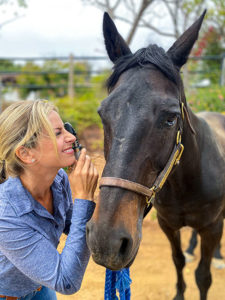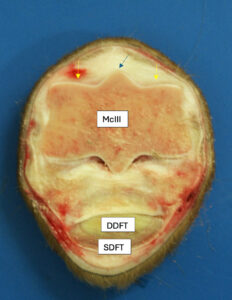Horse Hay Q&A

Equine nutritionists address real horse owners’ queries about this essential forage
We don’t lovingly refer to our horses as “hayburners” without reason. Hay is their primary feedstuff, and equine nutritionists recommend feeding 1.5 to 2% of their weight in hay or forage a day. For most horses, that usually pencils out to be 15 to 20 pounds. But no matter how long we’ve had horses, there always seems to be more to learn about hay and choosing the right type.
How does hay quality affect overall diet? How can you deal with variable quality? When and how should hay be soaked or steamed? Why use hay feeders?
To jump-start my research on this topic I posted on social media, soliciting questions from real horse owners. The ones I got were excellent and intriguing. For the answers I consulted with three experts on hay and equine nutrition.
Clair Thunes, PhD, is an independent equine nutrition consultant who owns Summit Equine Nutrition, in Arizona. She works with owners, trainers, and veterinarians to take the guesswork out of feeding horses, from World Equestrian Games competitors to backyard-roaming Miniature Donkeys.
Natalie Shaw, PAS, is an equine nutritionist and lifelong horse owner based in the Pacific Northwest. She is pursuing a master of science from Washington State University, studying the effects of growing and harvesting methods on teff hay’s nonstructural carbohydrate values.
Emily Glunk Meccage, MS, PhD, is an extension forage specialist and assistant professor at Montana State University, in Bozeman. She co-owns Field and Fodder Consulting LLC, a private equine nutritional consulting company. Since 2014 she has been studying the forage-animal interaction, as well as best management practices for forage production.
Now, let’s get to the questions!
Q: What are warm- and cool- season grasses, what regions do they grow best in, and do they make good hay?
Warm-season grasses, such as Bermuda grass, dallisgrass, pearl millet, and crabgrass, grow best in higher temperatures and in most cases are more water-efficient than cool-season species.
“They generally have lower protein and digestibility and higher fiber than cool-season grasses at similar maturity stages,” says Meccage. “These grasses require soil temperatures to be around 55 degrees F before they even start germinating and growing. We grow them all throughout the U.S., but not every area is suited for them.
“For instance, in Montana warm-season species have been working really well in many places,” she continues. “However, at some of the higher elevations, we don’t have enough days at higher temperatures to allow for optimal growth, so we generally don’t see them there. And we are not able to grow any perennial warm-season species—only annual ones—whereas in the Southern U.S., they can grow perennial species that can survive the more mild winters.”
Cool-season species grow best in the spring and fall, with cooler temperatures and plenty of moisture. These include orchardgrass, timothy, fescue, Kentucky bluegrass, and perennial ryegrass.
“These make great hay sources and, depending on maturity, can be high in protein, energy, and digestibility,” says Meccage. “Legumes like alfalfa and sainfoin are also considered to be cool-season species, which … are extremely high in protein, as well as a good energy source. These work well all over the U.S., and many are commercially grown throughout.”

Q: When people refer to a first, second, etc., cutting of hay, what do they mean?
This number describes how many times a hayfield has been cut during a growing season. “The first time a field is cut in the year is the first cutting and, depending on the part of the country, is done usually in May or June,” says Thunes. “The field is then allowed to regrow and is recut, which would be the second cutting. The part of the country and the length of the growing season typically determine how many cuttings there are.”
Cooler, high-elevation areas such as Wyoming get one cutting. “Some parts of California get as many as six to seven cuttings of alfalfa,” says Thunes, “sometimes even eight.” Most areas, however, only get one to two cuttings of grass hay.
“There is this philosophy that second cutting is best and that first cutting may be more mature and stemmy than is desirable—or that there may be more weeds in the first so a second cutting would be ‘cleaner,’ ” she adds.
For horses in life stages or careers without high demands, this stemmy, less digestible hay with greater ‘chew time’ is perfectly fine and might even be desirable. It’s not a good choice, however, for high-performance horses, lactating broodmares, or weanlings, which all have greater nutritional needs, says Thunes.
As far as which cutting has lower nonstructural carbohydrates (NSCs—something to avoid if you have insulin-resistant and easy-keeper horses), “with more mature hay we would expect lower levels of NSCs, but the only way to know for sure is to test it,” says Thunes.
Q: Is one grass hay variety more palatable than another?
Researchers have performed a variety of studies evaluating forage palatability for horses. “In general, one of the biggest impacts is going to be maturity of the grass at harvest,” Meccage says. “The later it is cut, the stemmier and more fibrous it is going to be, which will decrease palatability. If you see lots of stems and seedheads, with few leaves, you can probably expect higher refusal compared to a leafier hay. The most common species I see used and sold as horse hay are orchardgrass, timothy, tall or meadow fescue, smooth bromegrass, and alfalfa. All of these, when presented in dry form, usually are going to be fairly palatable to a horse.”
Q: How does hay quality affect overall diet? How can I get and interpret a hay analysis?
“Hay quality is everything,” Shaw says. In addition to palatability, it affects digestibility and the horse’s glucose response. It tells you how much to feed daily and what you might need to supplement to meet your horse’s nutritional needs.

“I think it’s important to understand that hay quality can be separated into two categories,” she adds. “There’s an aesthetic quality (i.e., green, leafy, and dust-, weed-, and mold-free), but there is also an analytical quality (i.e., how well the forage meets your horse’s needs). I always stress the difference between these two, as a quality analysis for one horse may be very different from another horse.”
Perhaps you have purchased a load of hay without a hay analysis, and now you want to have one done. “Any county with an extension office should be able to help you with that,” says Shaw. “Borrow their hay probe, or perhaps they can assist you with getting the hay sample (done) and sent out for analysis.”
All land grant universities have a state forage agronomist who should also be able to assist you; your local extension office can help you get in contact with that person.
You might also go through your local feed dealer. “Most or all feed companies have a regional or local feed rep that can help,” says Shaw. “Most carry a hay probe and will often come out and do a hay analysis for free for horse owners. Not only are feed reps horse-savvy but they have a regional understanding for things like selenium deficiencies.”
She adds that if you purchase hay in bulk, you might be able to request that the grower provide a forage analysis as a value-added component, which should only cost them about $50. “As hay prices go up, we need to be more demanding from our hay growers,” Shaw says.

Q: When should I soak or steam hay?
Horses with metabolic disorders such as insulin resistance benefit from hay soaking to remove some of the sugars. “If the sugar content is unknown, it is generally suggested to soak (each meal of) hay in order to remove and lower the water-soluble carbohydrates consumed,” says Thunes. The same is true for owners who are trying to reduce the amount of calories their overweight horses consume.
When soaking hay, Thunes suggests filling the haynet first, then submerging it completely in water (such as in a clean muck bucket) for 60 minutes. Hang the haynet over a drain to allow excess water to drip away, and then feed. “Be careful, as in some climates it may begin to ferment quickly,” says Thunes.
As for steaming hay, “research shows steaming is primarily helpful with respiratory issues,” she says. “It helps get rid of dust and mold in hay,” but has less effect on NSC levels than does soaking.
Q: How do I know if my hay is not adequate for my horse’s health, and when should I consider switching hay types?
The most important thing is to monitor your horse’s body condition. “If you are feeding a grass hay and (your horses) are underweight, try feeding more,” says Thunes. “If they don’t gain weight you might consider adding some alfalfa hay, since it has more calories per pound. By the same token, if your horse is overweight try a lower-calorie hay,” such as a mature grass hay, which is usually lower in both quality and calories.
“Ideally, you don’t want to reduce the amount of forage you are feeding, so instead switch to a lower-calorie hay so you can feed the same amount,” she says.
Thunes adds that weighing hay is critical, as it’s nearly impossible to accurately guess how much you are feeding. Use a scale to avoid over- or underfeeding and save money in the long run. Place the hay in a haynet and hang it on a fish scale, or place a flake on a flat-surface scale.
Q: How do I make a decision when faced with all the potential hay variabilities and options?
The answer to this question depends on what your priorities are when feeding your horse. “If you have a horse with respiratory issues, then perhaps hay with as little dust as possible is your greatest concern,” says Shaw. “If you have an overweight or insulin-resistant horse, then perhaps low NSCs are important to you. If you have young horses or lactating broodmares, then nutrition and protein content may be a priority.”
Or maybe the deciding factor is price, availability, palatability, lower energy, and organically grown. Is finding a dealer who will deliver and stack a pivotal point? Communicate this to your hay dealer or grower, and find a forage that meets as many of your top priorities as possible.
Be realistic, however, and realize you will probably have to pay more to get more. “If you want inexpensive green hay, with no weeds or dust, delivered yesterday, with less than 10% NSCs,” Shaw says, “chances of getting all those things at once is next to impossible, so you’ve got to prioritize.”
Q: How much protein does a horse need during different stages of life, and can I provide this with hay alone?
“Most mature horses are being fed more protein than they need,” says Thunes. “The ones that need the most protein are the young, growing weanlings and lactating broodmares.”
How much protein a horse consumes also depends on how much hay he’s being fed. “If you feed a limited amount of hay, then the protein in that hay may need to be higher,” she says. “Otherwise, you can feed more pounds of hay with a lower percent of protein. For horses being fed (free-choice) hay, the percent protein can be less.”
A good-quality grass hay fed at 1.5 to 2% of body weight will meet most horses’ protein requirements. Broodmares and weanlings might need a commercial feed or alfalfa hay to meet their higher protein requirements, says Thunes.

Q: How do I know if there’s enough selenium in the soil where my hay was grown, and when should I supplement?
Selenium plays many roles in a horse’s body, but perhaps most important are as an antioxidant and thyroid hormone metabolism regulator. “Selenium levels in plants are dictated by the soil it was grown in and whether the plant is one that accumulates selenium, so knowing where your hay was grown and whether it’s a high- or low-selenium soil area will help,” Thunes says, adding that a Google search will bring up maps of regional selenium levels.
“Generally, soil (selenium) levels in the Pacific Northwest are low,” she says. “Some northeast and central states are high. If you are in an area where it’s known to be low, it’s safe to say you need a selenium supplement. You may not need to supplement if you are already feeding a vitamin-mineral supplement or a commercially fortified feed, as both of these likely already have selenium in them.”
Hay analyses don’t usually include selenium levels; the most accurate way to test if your horse’s selenium needs are being met is with bloodwork. Ask your veterinarian if you need to test for and supplement it in your horses.
Q: What are the pros and cons of buying compressed hay?
One of the biggest benefits compressed hay offers is its smaller package. “This makes it easier to transport and maneuver,” says Meccage. The tight packaging makes for a denser bale and can help prevent weathering from rain or snow.
“However, that higher density also has potential to create more problems if the hay was baled too wet, (because) there is less opportunity for it to dry down to a safe level after baling,” she adds. “Companies and producers are very aware of this and work hard to ensure that this does not occur, through the use of things like moisture testers or quality analysis.”
Q: Is there a nutritional difference between irrigated and dryland hay?
The difference between irrigated and dryland hay primarily has to do with maturity at harvest, rather than watering practices. “With most irrigated fields, because the plants aren’t water-stressed, they aren’t going to mature as rapidly, so the producer can harvest at a slightly more immature stage and still have improved regrowth,” says Meccage. “In the traditional dryland sense, like what we have here in the West, to make up for the slower growth and still have enough yield, producers may harvest a little later. But this is not always the case and can vary from producer to producer, field to field.”

Q: What weeds found in hay or toxic to horses?
Depending on where you live, you might have to keep an eye out for a variety of weeds. Your local extension office or land grant university, as well as veterinarians and equine nutritionists, can help you know what to look for in your area.
“Common concerns I look for, and which can be found in many places throughout the U.S., are poison hemlock and water hemlock, tansy ragwort, Russian knapweed, and hoary alyssum,” says Meccage. “The best thing to do is become familiar with the plants in your area and develop a good relationship with your hay producer, who can tell you what weeds are in the general vicinity.”
Q: Should I be concerned about the use of herbicide glyphosate in growing hay?
Glyphosate is not commonly used in hay production during the growing season, says Meccage, except in the case of RoundUp Ready alfalfa. This nonselective (kills both grasses and broadleaf plants), burn-down (controls plants already emerged and growing) herbicide is broad-spectrum, meaning it kills whatever vegetation it touches.
“It is mainly going to affect the tissue it is applied to, but there is some translocation to other parts of the plants (i.e., the roots),” says Meccage. “More commonly it will be used very early in the spring when weeds are starting to grow but before our desired forage has broken dormancy. In most cases it does not make sense to apply glyphosate in-season, as it will kill all forage it touches.”
Meccage says all herbicides have what is called a preharvest or pregrazing interval. “This means that strenuous testing has been done to determine how long it takes for that chemical to break down so that it won’t be ingested or be available at high enough amounts to create any issues in our livestock or horses,” she says. “Luckily for us, glyphosate has a relatively short half-life, so it breaks down fairly readily and is safe for grazing or haying shortly after application (as well as being safe for us to handle). The same rule follows for other common herbicides such as GrazonNext (a broadleaf herbicide often used in grass pastures). Horse owners should keep in mind that it is illegal for any producer to harvest or allow animals to graze a field prior to the harvest/grazing interval.”
While many producers strive to limit the amount of herbicide they apply—because it costs time and money—their end goal is to have a healthy stand of hay that can outcompete weeds. Eliminating those weeds with herbicides is often still the most economical option, says Meccage.
“My best advice is to get to know your producer,” she says. “If local, you can ask questions of what weeds they deal with and what herbicides they use. Almost all producers are very cognizant of the rules and regulations surrounding herbicide application. In general, even if your hay had been spot-sprayed with glyphosate that season, it is going to be safe, with extremely low to zero amounts of residue by the time you need to feed it.”
Take-Home Message
Because forage is the basis of all horses’ diets, it’s critical that we understand what we’re feeding and what hay options are out there. I hope the ideas and guidelines these nutritionists provided will equip you well for your hay-finding and feeding journey.

Related Articles
Stay on top of the most recent Horse Health news with


















